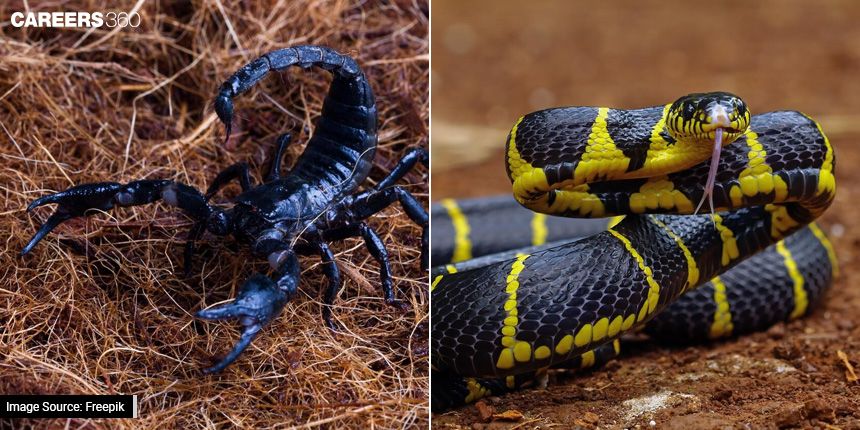Venomous vs Poisonous Animals: Understanding Toxins And Their Effects
There is an abundance of adaptations shown by animals in our environment; the most intriguing one is the mechanism used by certain species to deliver toxins and poison.
This Story also Contains
- Venomous vs Poisonous: What are the Distinctions?
- Toxins and Their Ecological Roles
- Human Interactions and Medical Implications

Whether as predators, as a defence mechanism, or in competition, toxins play a pivotal role in the survival strategies of numerous animals. To comprehend the dynamics of these chemical defences, it is essential to distinguish between venomous and poisonous organisms and explore the diverse effects their toxins can have.
Venomous vs Poisonous: What are the Distinctions?
Venomous Animals
Venomous creatures actively inject their toxins into other organisms, typically as a means of subduing prey or defending against predators. This specialised delivery system often involves fangs, stingers, or spines designed to pierce the skin and deliver the toxic payload directly. Some notable examples of venomous animals include snakes, spiders, and certain species of jellyfish.
Delivery Mechanisms:
Fangs: Snakes and spiders often possess specialised fangs for injecting venom into their prey or attackers.
Stingers: Bees, wasps, and scorpions use stingers to deliver venom, primarily for defence.
Effects of Venom:
Neurotoxic Effects: Some venoms target the nervous system, causing paralysis or disruption of neural signals.
Hemotoxic Effects: Other venoms may affect the blood, leading to issues such as clotting or internal bleeding.
Poisonous Animals
In contrast to venom, poison is typically delivered passively, with toxins sequestered within the animal's body or on its skin. These toxins deter predators from attempting to consume the poisonous organism. Frogs, certain insects, and some snakes are examples of poisonous animals.
Delivery Mechanisms:
Skin Secretions: Poisonous frogs, such as the poison dart frog, secrete toxins through their skin as a defence mechanism.
Ingestible Toxins: Some snakes accumulate toxins from their diet, making them poisonous to predators that attempt to consume them.
Effects of Poison:
Dermatological Effects: Contact with the skin or ingestion of a poisonous animal may cause skin irritation or more severe reactions, depending on the toxic compounds involved.
Internal Effects: Ingesting the flesh of a poisonous organism can have systemic effects on predators, ranging from nausea to death.
Toxins and Their Ecological Roles
Ecosystem Balance
Toxins play a crucial role in maintaining ecological balance by influencing the interactions between species. The presence of venomous and poisonous animals shapes predator-prey relationships and contributes to biodiversity.
Preventing Overpopulation:
Predator Deterrence: Poisonous organisms deter potential predators, preventing unchecked population growth and promoting a balance within ecosystems.
Food Chain Dynamics:
Predator-Prey Coevolution: The arms race between predators and prey leads to the development of toxins and countermeasures, driving the coevolutionary dynamics of ecosystems.
Human Interactions and Medical Implications
Medical Applications
While toxins from venomous and poisonous animals can be harmful to humans, they also hold significant medical potential. Researchers are exploring these compounds for their pharmacological properties, seeking to develop new drugs and treatments.
Pain Management:
Analgesic Properties: Some venom components, such as peptides in snake venom, show promise for developing pain-relieving medications.
Disease Research:
Antimicrobial Properties: Toxins from certain animals exhibit antimicrobial activity, offering potential leads for novel antibiotics.
Mitigating Human-Wildlife Conflicts
Understanding the behaviours of venomous and poisonous animals is essential for mitigating conflicts between humans and wildlife.
Education and Awareness:
Public Awareness Campaigns: Educating communities about the presence and behaviour of venomous and poisonous animals helps reduce accidental encounters and promote coexistence.
Antivenom Development:
Research and Production: Ongoing research into venoms contributes to the development of effective antivenoms, crucial for treating envenomation cases.
Venomous and poisonous animals wield a fascinating array of toxins, showcasing the complexity of nature's survival strategies. Distinguishing between venom and poison, understanding the ecological roles of toxins, and exploring their potential in medical science underscore the importance of studying these remarkable adaptations. As human-wildlife interactions increase, cultivating awareness and respect for these creatures becomes paramount, paving the way for harmonious coexistence and the continued exploration of the secrets hidden within the world of toxins.
